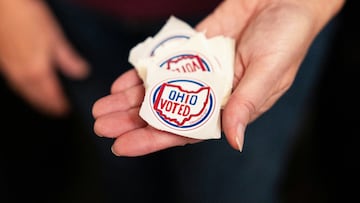Does Ohio always predict the winner of the US election? The story of the projection state
Ohio voters only diverged from the Electoral College twice in the 20th century, informally making it the ‘Projection State’ by political analysts. Does this nickname still stand?


In 2008 and 2016, President Barack Obama won the state of Ohio after President George W. Bush came out victorious in the elections of 2000 and 2004. For Democrats, the Buckeye state became part of the strategy, and while not reliably blue, was a place the party might be able to look to pick up a few more electoral college votes. That changed in 2016 when Donald Trump beat Hillary Clinton by 8 points. In 2020, Joe Biden could not make up ground and still lost the state by the same figure.
Follow AS’s live coverage of Election Day and the count in swing states
- Pennsylvania US Election Results 2024 live
- Wisconsin US Election Results 2024 live
- Georgia US Election Results 2024 live
- Nevada US Election Results 2024 live
- Michigan US Election Results 2024 live
- North Carolina US Election Results 2024 live
- Arizona US Election Results 2024 live
Ohio’s voting history holds significant weight in the political landscape. Before 2016, the state had consistently voted for the winning presidential candidate in every election since 1960, when Buckeye State voters chose Richard Nixon over John F. Kennedy. The only other instance in the 20th century where Ohio voters diverged from the Electoral College was in the 1944 election when they voted for Republican Thomas E. Dewey instead of Democrat Franklin D. Roosevelt, who was seeking and eventually secured his fourth term as President of the United States.
Many major polling organizations have not been surveying voters in Ohio, as it is not considered a safe state for Trump. They believe their efforts are better spent in some of the neighboring swing states. However, Miami University in Ohio recently released a poll showing that Donald Trump is leading Kamala Harris by only three points, with a margin of error of 5 percent.
Ohio Presidential Polling:
— Polling USA (@USA_Polling) November 2, 2024
Trump (R): 49%
Harris (D): 46%
Miami University / Oct 30, 2024 / n=853 pic.twitter.com/7HEpfJ4hoN
Democratic Senator Sherrod Brown is polling ahead of his Republican challenger by a similar margin. These polls suggest that the state might be shifting away from the GOP, but this hypothesis cannot be confirmed until Tuesday when the majority of the state’s residents go to the polls.
Ohio, deindustrialization and the ‘Blue Wall’
Related stories
Before 2016, Ohio was a beacon of the country’s political sentiments, a great indicator of the nation’s political pulse. However, as the state has deindustrialized and shifted towards the right, it has lost this prestigious status, a significant change that reverberates in the political landscape.
Some of Ohio’s Midwestern neighbors, Pennsylvania, Michigan, and Wisconsin, are considered the ‘Blue Wall,’ and they share many similarities with Ohio. All were industrial hubs that saw their economies boom in the 20th century. However, many towns have not recovered from the decline in manufacturing, as new jobs did not replace the old in terms of pay and working conditions.
Complete your personal details to comment